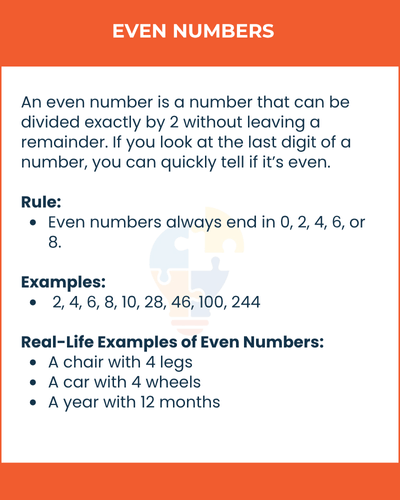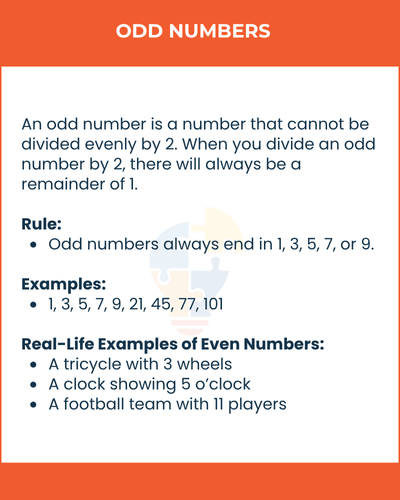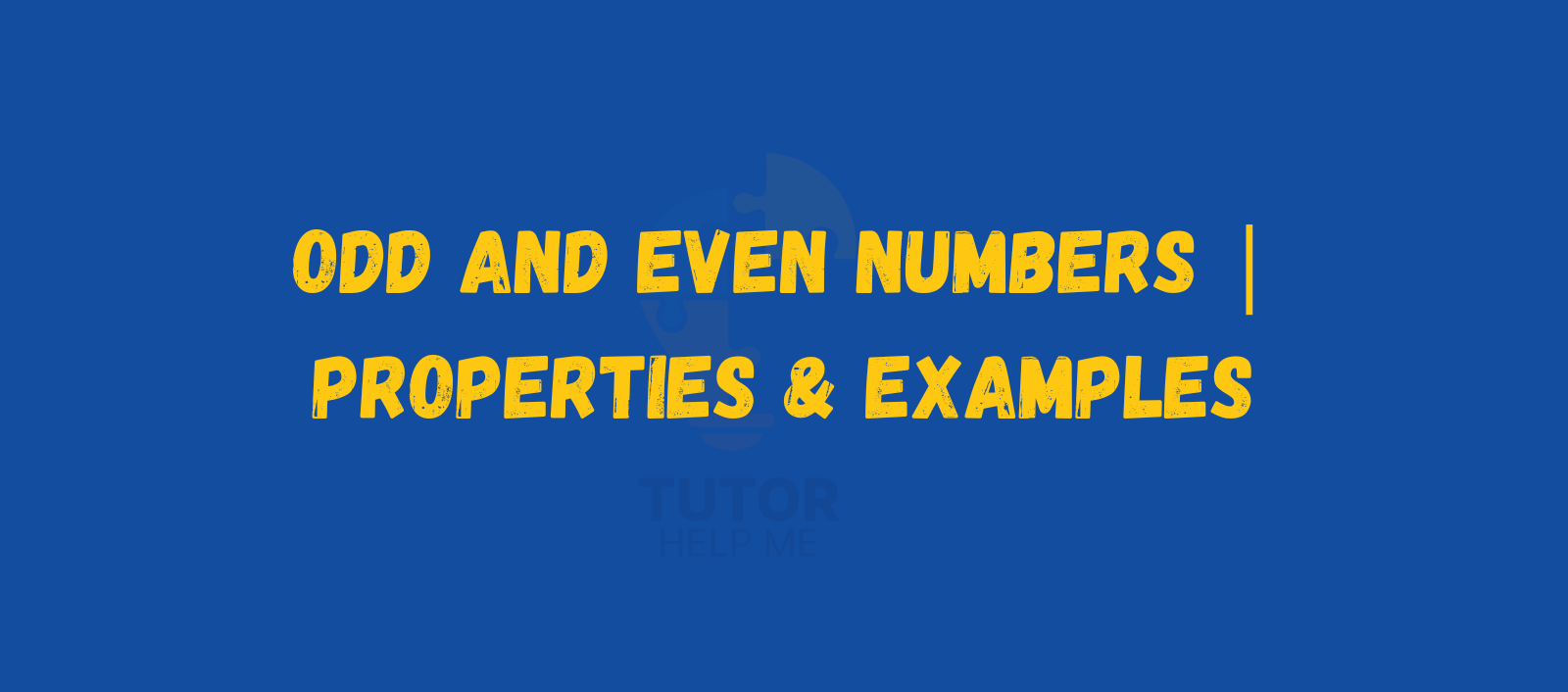Have you ever noticed how some numbers can be divided into equal groups, while others cannot? That’s where odd and even numbers come in.
This guide will help you understand their definition, properties, lists, and how to check if a number is odd or even. By the end, you’ll have a clear idea of how these numbers work in maths and daily life.
Let’s start with the basics.
What are Even Numbers?
An even number is a number that can be divided exactly by 2 without leaving a remainder. If you look at the last digit of a number, you can quickly tell if it’s even.
Rule:
Even numbers always end in 0, 2, 4, 6, or 8.
Examples of Even Numbers:
2, 4, 6, 8, 10, 28, 46, 100, 244
Real-Life Examples of Even Numbers:
- A chair with 4 legs
- A car with 4 wheels
- A year with 12 months

What are Odd Numbers?
An odd number is a number that cannot be divided evenly by 2. When you divide an odd number by 2, there will always be a remainder of 1.
Rule:
Odd numbers always end in 1, 3, 5, 7, or 9.
Examples of Odd Numbers:
1, 3, 5, 7, 9, 21, 45, 77, 101
Real-Life Examples of Odd Numbers:
- A tricycle with 3 wheels
- A clock showing 5 o’clock
- A football team with 11 players

Properties of Even Numbers
Even numbers follow certain rules. These rules make calculations easier and help in identifying number patterns.
1) Property of Addition
When two even numbers are added, the result is always even.
Example: 10 + 4 = 14 (even)
2) Property of Subtraction
The difference between two even numbers is always even.
Example: 20 − 6 = 14 (even)
3) Property of Multiplication
The product of two even numbers is always even.
Example: 8 × 2 = 16 (even)
4) Property of Division
When one even number is divided by another even number (and divisible), the result is an integer.
Example: 16 ÷ 2 = 8
Properties of Odd Numbers
Odd numbers also have unique properties that make them easy to identify.
1) Property of Addition
The sum of two odd numbers is always even.
Example: 7 + 5 = 12 (even)
2) Property of Subtraction
The difference between two odd numbers is always even.
Example: 9 − 3 = 6 (even)
3) Property of Multiplication
The product of two odd numbers is always odd.
Example: 3 × 5 = 15 (odd)
4) Property of Division
Odd numbers are not divisible by 2. Dividing always leaves a remainder of 1.
Example: 11 ÷ 2 = 5 remainder 1
List of Even Numbers up to 100
Here is the complete list of even numbers from 2 to 100:
- 2, 4, 6, 8, 10, 12, 14, 16, 18, 20,
- 22, 24, 26, 28, 30, 32, 34, 36, 38, 40,
- 42, 44, 46, 48, 50, 52, 54, 56, 58, 60,
- 62, 64, 66, 68, 70, 72, 74, 76, 78, 80,
- 82, 84, 86, 88, 90, 92, 94, 96, 98, 100
List of Odd Numbers up to 100
- 1, 3, 5, 7, 9, 11, 13, 15, 17, 19,
- 21, 23, 25, 27, 29, 31, 33, 35, 37, 39,
- 41, 43, 45, 47, 49, 51, 53, 55, 57, 59,
- 61, 63, 65, 67, 69, 71, 73, 75, 77, 79,
- 81, 83, 85, 87, 89, 91, 93, 95, 97, 99
How to Check if a Number is Even or Odd?
You can identify even and odd numbers quickly by following these steps:
- Step 1: Look at the last digit of the number.
- Step 2: If the digit is 0, 2, 4, 6, or 8 → it’s even.
- Step 3: If the digit is 1, 3, 5, 7, or 9 → it’s odd.
Examples:
- 324 → last digit 4 → Even
- 739 → last digit 9 → Odd
What are Even and Odd Decimals?
Decimals can also be classified as odd or even depending on their whole number part.
- If the whole number part is even, the decimal is even.
- If the whole number part is odd, the decimal is odd.
Examples:
- 14.6 → whole number 14 → even
- 21.3 → whole number 21 → odd
Difference Between Odd and Even Numbers
| Feature | Even Numbers | Odd Numbers |
|---|---|---|
| Divisibility | Divisible by 2 | Not divisible by 2 |
| Ending digits | 0, 2, 4, 6, 8 | 1, 3, 5, 7, 9 |
| Example | 10, 22, 46, 100 | 3, 15, 77, 101 |
| Addition rule | Even + Even = Even | Odd + Odd = Even |
| Multiplication rule | Even × Any number = Even | Odd × Odd = Odd |
Facts About Odd and Even Numbers
- 0 is an even number.
- The only even prime number is 2.
- Adding an even and an odd number always gives an odd number.
- Multiplying two even numbers always gives an even number.
- Every alternate number is odd and even in sequence.
Conclusion
Odd and even numbers are the simplest classification of numbers, yet they form the base of many mathematical concepts. Even numbers are divisible by 2, while odd numbers are not.
Their properties in addition, subtraction, and multiplication make them predictable and easy to work with. From counting objects to solving equations, odd and even numbers are everywhere in daily life.
Understanding them helps students build strong foundations for advanced mathematics.
Read More Types of Numbers in Maths
FAQs
Q1: Is 0 an even or odd number?
A: 0 is an even number because it is divisible by 2.
Q2: Can negative numbers be even or odd?
A: Yes, −2 is even, −5 is odd.
Q3: Why is 2 the smallest even number?
A: Because it’s the first number greater than 1 that can be divided by 2.
Q4: Is every multiple of 2 an even number?
A: Yes, all multiples of 2 are even.
Q5: Can a number be both odd and even?
A: No, a number can only be odd or even, never both.
Q6: Are all prime numbers odd?
A: No, 2 is the only even prime number.
Q7: What happens when you add odd and even numbers?
A: The result is always odd.
Q8: What is the smallest odd number?
A: The smallest odd number is 1.
Q9: How do odd and even numbers help in maths?
A: They help in identifying patterns, divisibility, and problem-solving.
Q10: Are decimals odd or even?
A: Decimals are classified based on their whole number part.

